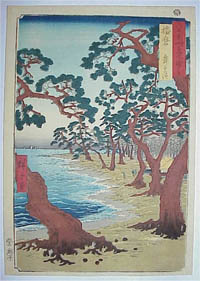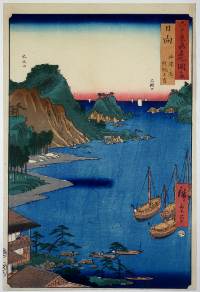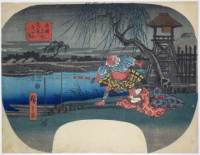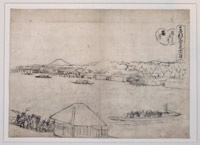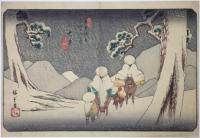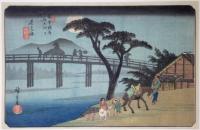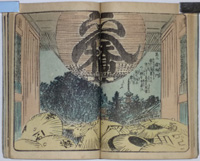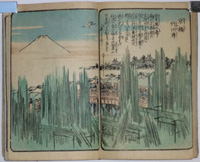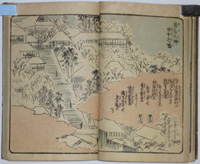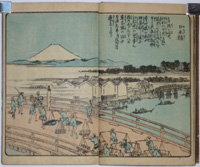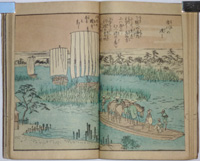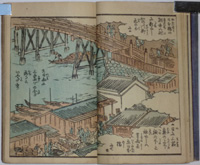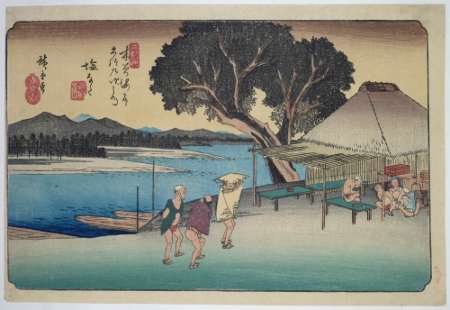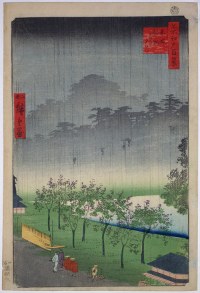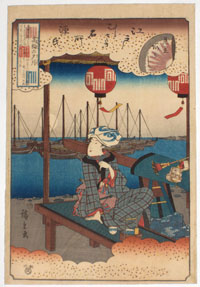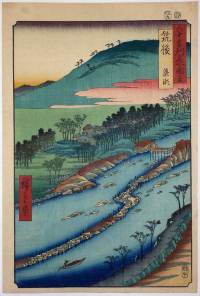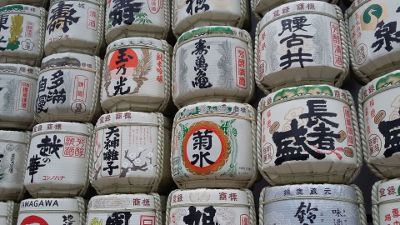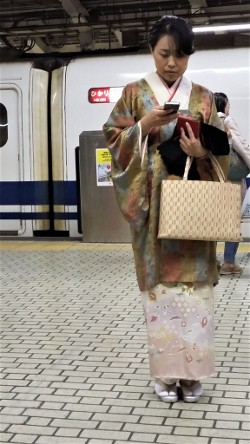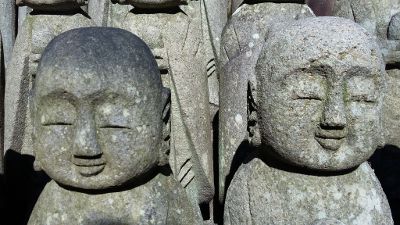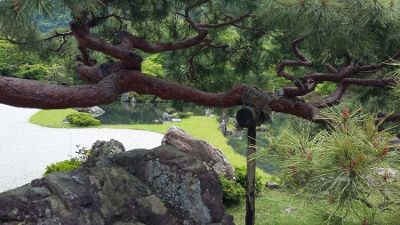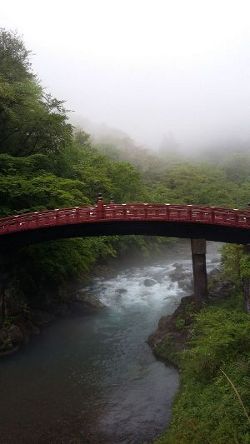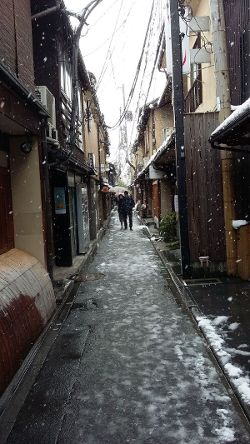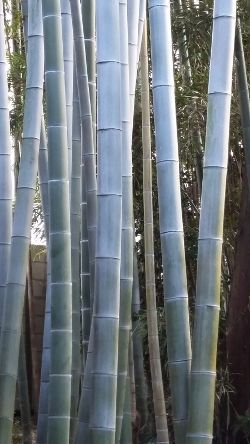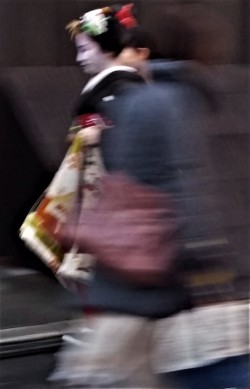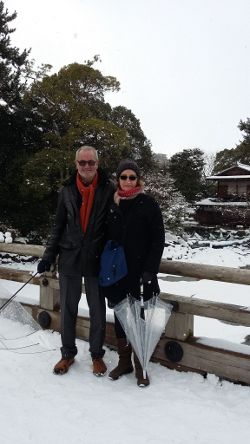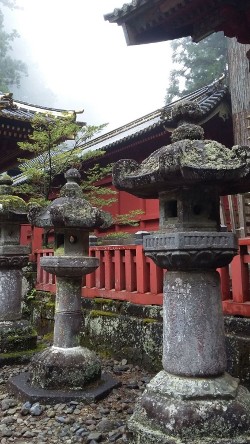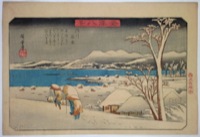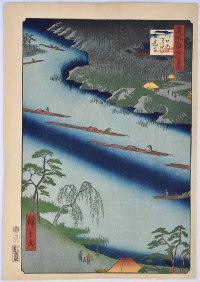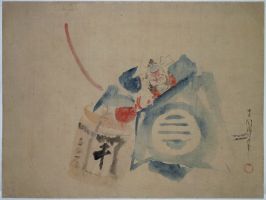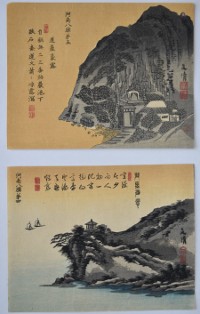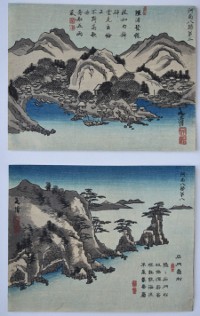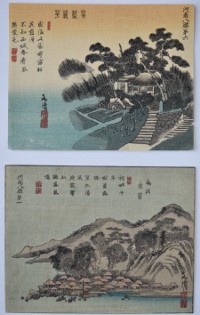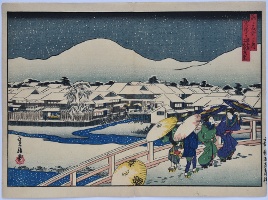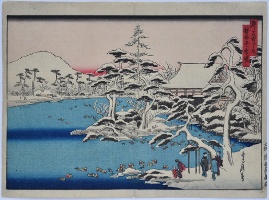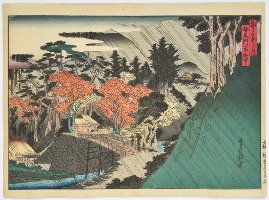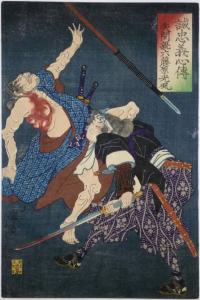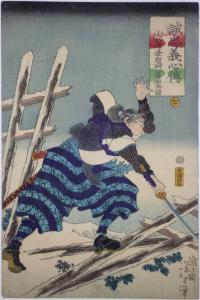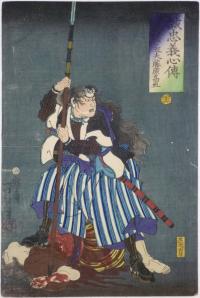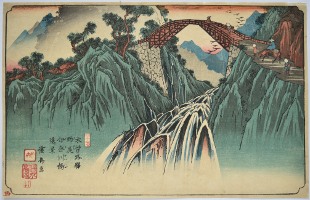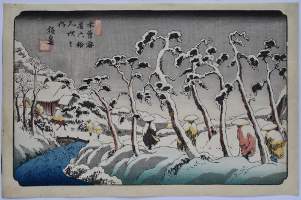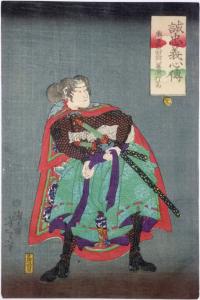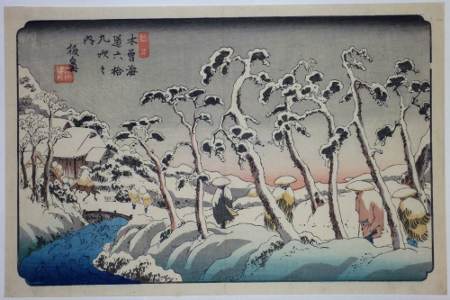Ichiryusai HIROSHIGE (1797-1858)
Click here to view image full size.
The beach of the Dancing Girl in Harima Province from Rokuju-yo shu meisho zue, “Famous Places in the Sixty-Odd Provinces”. The set published by Koshihei between 1853-1856.
Very good early impression showing strong woodgrain. Fine colour and condition. Signed Hiroshige ga.
Status: Sold
Ichiryusai HIROSHIGE (1797-1858)
Click here to view image full size.
A chuban triptych showing three beauties relaxing at Takanawa from a set of Eight Views of Edo. Published by Joshuya Kinzo c.1849-50. (Tamba no.146.)
Very good impression, colour and condition. Signed Hiroshige ga.
Status: Sold
Ichiryusai HIROSHIGE (1797-1858)
Click here to view image full size.
Hyuga Province, Yudzu-no Minato from Rokuju yoshu meisho zu, “Famous Places in the sixty-Odd Provinces.” The set published by Koshimuraya Heisuke between 7/1853 and 3/1856 (this being 1856). Shows tea houses looking out over the bay.This is the extremely rare first edition.
Superb impression of the earliest state with beautiful bokashi and woodgrain showing on all blocks. Fine colour and condition. Signed Hiroshige ga.
Status: Sold
Ichiryusai HIROSHIGE (1797-1858)
Click here to view image full size.
An extremely rare uncut fan from a set Shokoku meisho, “Famous Places in Various Provinces.” Musashi Yaguchi no Watashi. Although ostensibly a set of landscape prints, Hiroshige inserts popular kabuki scenes into the locations. This shows the ferryman Watashimori Tombei with his daughter O-Fune in the famous scene from the play Shinrei Yaguchi no Watashi showing them before the bell tower beside the Tama River. Published 1843-46 by Ibayakyu (Ibaya Kyubei). Another from this set is illustrated in Rupert Faulkner, Hiroshige Fan Prints, V & A, 2001, p 137, no 106 (and illustrated on the cover). Two other designs from the set are illustrated in Hiroshige Fan Prints, Unsodo, 2010, pls 132 and 133. Interestingly, the latter has identical binding holes near right edge to the example offered here. An indication that these probably came from the same sample book the publisher kept to take orders from clients. This accounts for its survival. Possibly the only impression extant.
Very fine impression and colour. Small binding holes near right edge, otherwise very good condition. Signed Hiroshige ga.
Status: Sold
Utagawa HIROSHIGE (1797-1858)
Click here to view image full size.
An original preparatory drawing for an unpublished set: Toto Fujimi junigatsu, “Mount Fuji Viewed from the Eastern Capital Through the Twelve Months”, this being Mutsuki. Sumi on paper, c. 1850-55, 9.5 x 13.75 in; 24.5 x 35 cms. Shows a full ferry crossing the Sumida. Slight soil and centrefold, but generally very good condition. Ex collection Beres, sold Paris 2002, lot 182.
Status: Sold
Ichiryusai HIROSHIGE (1797-1858)
Click here to view image full size.
Oi, a suburb of present day Ena City, is in the southern foothills of the central mountain range now known as the Japan Alps. Shows a group of travellers heavily protected against the snow and cold. From Kisokaido rokujukyutsugi no uchi, “Sixty-Nine Stations of the Kisokaido.” The set of seventy prints was started by Eisen and published by Hoeido in 1835, but in 1837 Hiroshige took over and completed the series with the publisher Iseya Rihei ( Kinjudo ). One of Hiroshige’s most famous designs.
Very good impression. The earliest impressions have gradation on the Kiso range in the background and in the sky. Some versions are also known with splashed gofun. Very slight centre fold. Very good colour. Signed Hiroshige ga.
Status: Sold
Ichiryusai HIROSHIGE (1797-1858)
Click here to view image full size.
Nagakubo, one of the major designs from Kisokaido rokujukyutsugi no uchi, “Sixty-Nine Stations of the Kisokaido.” The set of seventy prints was started by Eisen and published by Hoeido in 1835, but in 1837 Hiroshige took over and completed the series with the publisher Iseya Rihei ( Kinjudo ). Shows travellers near and on the Wada Bridge over the Yodo River. As with most important compositions from the set, there are numerous states where the printers/publishers experimented with alternative wipings to alter the design: On some impressions the far mountains are not seen; on others they are graded-off to the right. The far rail on the bridge comes and goes and the blue gradation on the river varies. The earliest state appears to omit the mountains and have bokashi around the moon. ( Late editions also omit the mountains. )
Very good early impression with extra bokashi across the moon. Remargined on the two vertical sides, otherwise very good condition. Very good colour. Signed Hiroshige ga.
Status: Sold
Ichiryusai HIROSHIGE (1797-1858) ET AL
Click here to view image full size.
Four volumes ( vols 5, 6, 8, 10 ) Ehon miyage, “Souvenirs from Edo.” The series of ten volumes was published between 1850 ( vol 1 ) to 1867 ( vol 10 ). Originally intended to be four volumes, the other books were gradually added. Volume 8 has a preface stating that Hiroshige had passed away but that he had left enough drawings to continue the series. Volume 10 was designed by Hiroshige II. Very clean good impressions with original covers and title slips. One hole on volume 6, otherwise very good condition. Each book also has the original paper slip-cases sewn on ( rare ). These have saved the covers and especially the title slips which are almost mint. Publisher Kinkodo, Kikuya Kozaburo, 1850 – 67.
Status: Sold
Ichiryusai HIROSHIGE (1797-1858)
Click here to view image full size.
Shionada from Kisokaido rokujukyutsugi no uchi, “Sixty-nine Stations of the Kisokaido.” The set of seventy prints was started by Eisen and published by Hoeido in 1835, but in 1837 Hiroshige took over and completed the series with the publisher Iseya Rihei (Kinjudo). Shows boatmen and river porters in the early morning waiting for trade on the banks of the Chikuma River. The river was broad here and the ferry did not always cross. The porters would be engaged to take travellers across on platforms or even on their backs.
Fine and extremely early impression. The corner of the publisher’s seal always shows broken off, even on the earliest impressions. Fine colour. Left border trimmed, otherwise fine condition. Signed Hiroshige ga.
Status: Sold
Utagawa HIROSHIGE II (1826-1869)
Click here to view image full size.
Akasaka kiribatake uchu sekikei, “Evening View of the Paulownia Plantation at Akasaka Under Rain.” This is the replacement design for Hiroshige I’s version Akasaka kiribatake for the Meisho Edo hyakkei, “One Hindred Views of Edo” published by Uoya Eikichi between 1856 and 1858. This design dated 1859. Presumably the blocks were damaged for the first composition. A fine design and superior to Hiroshige I’s.
Fine early impression with mica to sky. There is an extremely rare first edition of this print with an added gradation of yellow to square cartouche and gradation on the yellow fence at left and roofs at right. Otherwise, the impressions are the same. The gradation in the background is particularly fine here. Fine colour. Slight soil to margin, otherwise very good condition. Signed Nisei Hiroshige ga.
Status: Sold
Ichiryusai HIROSHIGE (1797-1858)
Click here to view image full size.
Full moon at Takanawa. A bijin seated beside her palanquin at a tea house. A mitate set: Edo Murasaki meisho Genji, “Murasaki’s Genji in Famous Places of Edo.” Based on the Genji Monogatari with stylised clouds above and below in Yamato-e style. Published by Kinseido c1849-53. A very rare set: Late impressions being unknown.
Fine impression and colour. Light crease in left and right margin, otherwise fine
condition. Signed Hiroshige ga.
Status: Sold
Ichiryusai HIROSHIGE (1797-1858)
Click here to view image full size.
The fish trap in Chikugo Province from Rokuju yoshu meisho zue, “Famous Places in the Sixty-Odd Provinces.” The set published by Koshimuraya Heisuke between 7/1853 and 3/1856 (this being 9/1855). This is the extremely rare first edition and possibly one of the genuine first pulls as it is earlier than the Pulverer first edition. See my blog.
Superb impression of the earliest state with beautiful bokashi and woodgrain showing on all blocks. Fine colour. Two small paper flaws at top, otherwise fine condition. Full margins. Signed Hiroshige ga.
Status: Sold
Tsukioka YOSHITOSHI (1839-1892)
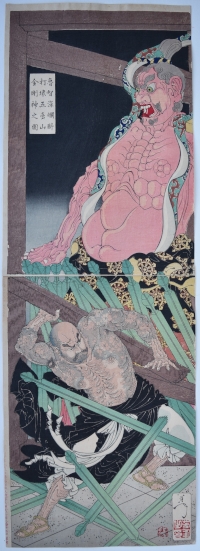
Click here to view image full size.
A vertical diptych showing Rochishin demolishing the temple gate on Mount Godai. There are conflicting versions of this event: Some suggest he gained entry to kill a gang of thieves. However, it seems that he was drunkenly staggering back to the temple after consuming a large quantity of wine and is barred entry by the monks. In a temper he demolishes the entrance and the large Buddhist guardian figure (Kongojin). The abbot dismisses him and sends him to a lesser temple. Rochishin ransui Godaisan Kongojin o uchikowasu no zu, “Picture of Rochishin in a Drunken Rage Demolishing a Guardian Statue (Kongojin) on Mount Godai.” Published by Matsui Eikichi, 1887. He figures in the Chinese classic Tales of the Water Margin, the Suikoden (jp. Suikoden) and is often referred to as the “Flower priest” because of his floral tattoos.
Very fine impression: This is the earliest state with a pigment used on the guardian’s torso that does not oxidise. (Exactly the same can be seen on the first editions of the Kinryusan Temple at Asakusa from Hiroshige’s 100 Views of Edo. Later printings use a different pigment on the huge lantern that oxidises badly.) It was also republished by Shimizuya Tsunejiro. Extensive burnishing. Fine colour. Very good condition. Signed Yoshitoshi.
Status: Available
Tsukioka YOSHITOSHI (1839-1892)
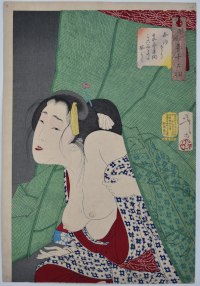
Click here to view image full size.
Looking Itchy: the appearance of a kept woman of the Kaei era [1848-1854]. Shows a beauty emerging from a mosquito net that has apparently not been entirely successful. From a set Thirty-two Aspects of Women published by Tsunashima Kamekichi, 1888. The set depicts women of different backgrounds and occupations from the Kansei era through to the Meiji era with punning allusions to their situation or mood.
Very fine impression with strong blind-printing on the fall. Fine colour and condition. Full size. Signed Hiroshige ga.
Status: Available
50th Anniversary of dealing – Part 2
In the 70s and 80s I was buying prints by such artists as Hiroshige, Hokusai, and Utamaro in the UK and in France and selling them in Japan. In Japan, I was buying prints by Yoshitoshi and Kuniyoshi. At that time those artists were not so highly valued by Japanese collectors.
I travelled to Paris every ten days or so and on almost every trip I was able to find something good. A lot of prints had been exported to France in the 19th century. Japanese art and culture enjoyed great influence in France at that time, the importance of ukiyo-e for the French impressionists is well known. Now it is difficult to find good quality prints in France and the prices fetched in auctions are often prohibitive.
At the time of my early trips to Japan in the 70s, there were not so many European or American visitors to Tokyo, visitor numbers to Japan were in the low 100,000s. Now visitor numbers are approaching 25 million per annum. My first experience of central Tokyo was a revelation – a real shock of the new! Tokyo’s highrise office blocks, its modern and efficient transport system, the bullet train all made London feel quite parochial. Because I had been studying ukiyo-e, Kyoto seemed much more familiar to me – if you squinted it was like being in a Hiroshige landscape.
My days were tiring ones of walking around shops in both cities. Prints could turn up anywhere. Outside of the cities it was not unusual for me to be followed by a gaggle of children for whom I was clearly a source of curiosity and general amusement.
I attended various auctions in Japan and often I was the only foreign dealer. The auctions were smaller then and some were held in ryokans in locations such as Hakone. Some dealers wore old style Japanese clothes (montsuki kimono beneath the montsuki haori and hakuma with socks and sandals). Everyone sat on tatami mats, the prints were passed around and bids were written on slips of paper in cardboard holders which were then thrown to the auctioneer. It was considered polite to bid on every few prints even if you didn’t want them; this was a matter of some delicacy which entailed making a bid low enough so as not to buy the item, but of course not so low that it would cause offense. Payment was cash only. Nowadays the accounts are computerised but in those days we had one man who did all the accounting on an abacus and would match a computer for speed. The auction was followed by dinner and then a dip in the communal male pool with much joshing.
At that time there was little interaction between Japanese dealers (except at these small auctions) and it was quite possible to buy a print from one shop, walk down the street and sell it to another shop because the dealers never went into each other’s premises. Over the years this has changed – as has so much else. I have been in the business for so long, I find myself dealing with the sons, daughters and sometimes the grandchildren of the dealers I met when I first travelled to Japan. I think that the aptitude for dealing and most importantly a good ‘eye’ must be carried in the genes.
The modern successor to those auctions is the official dealers’ auction held a number of times a year in the centre of Tokyo. They are much larger affairs with more foreign dealers and the ‘shout bid’ system mainly being used.
I was the first dealer to actively buy and champion surimono. In 1975 I had an exhibition of them and issued several catalogues of surimono over the following years. Then, as now, in fine surimono you can find exquisite sophistication in the cutting and printing of these short run editions for various poetry groups. In the 70s these wonderful prints were surprisingly affordable. Many surimono were exported from Japan in the latter part of the 19th century when there was a big demand for them, especially in Europe. To cope with this demand, from time to time, copies of surimono were produced. I think that the reasons that other dealers had avoided surimono in those early days was because of the risk of fakes and also expertise was determined by who had the opportunity to handle the genuine items. Because of the large number exported, curiously it was easier to find authentic surimono in France than it was in Japan.
In the Part 1 of this 50th anniversary blog I wrote about the importance of a good reference library, but to really know prints you also have to hold them in your hand. When handling prints the quality of the impression and of the paper is immediately evident. Surimono were printed on the finest of hosho which is a heavier paper that could hold the calligraphy, blind printing, and the addition of gold and other metals.
Another specific area in which I had an interest, which I still have to this day, is Shijo material: books, prints and paintings. In those early days Shijo was not considered collectable or as appreciated as formal styles. This changed somewhat after the publication of Jack Hillier’s The Uninhibited Brush in 1979.
Over the years I have noticed that prints travel in circles and I occasionally buy back the same items. I was passing an antique shop in the centre of Tokyo one time when I saw a first edition Hiroshige hanging on the wall. On inspecting it I realised that I had previously owned it. It was a very fine print so I purchased it again from that antique shop. That print had travelled between Japan and Europe four times to my certain knowledge. As it was some time ago, I am not sure where it went onto when I sold it next – it could be anywhere by now, I just hope that it has been cared for and is still in good condition.
I have had the pleasure of selling to many fine collectors. Then, as now, people find pleasure in their prints in different ways. For many years I sold Hiroshiges to one collector. She was a charming, elderly lady who one day confided to me that, whilst she loved the landscapes, she didn’t really like the bright colours. She told me that she had arrived at a method to get the colour saturation just as she liked it: she placed the prints in full sun on her balcony with pebbles on each corner and left the colours to fade until she was satisfied. Whilst I remember her fondly I do wince when I think of mint condition prints being intentionally faded.
Especially at this time when fine prints are increasingly difficult to find, I think of dealers and collectors alike as custodians for the next generations. I ask that you please look after your prints sensibly. Prints should be stored in acid free paper away from light and damp. They can be displayed but should be kept away from direct sunlight and rotated occasionally; and ideally not sealed in frames so that they can breathe.
About two years ago I viewed an auction in London that had four surimono. I saw that they were purchased from me about 20 years ago. My price for these surimono, which at that time were in pristine condition, was £25. Unfortunately, they had been stored somewhere damp and their condition was very poor. If they had been well looked after and had remained in fine condition I would have happily paid £2000 each for them but, as it was, I didn’t consider buying them. Many prints have become ghosts of their original selves because they have not been sensibly looked after.
I should like to thank those of you who are collectors and those who are interested in the research that I have done over the years; warm thanks to my colleagues for their companionship and shared knowledge; and last but not least, thanks to my wife Lynne for her interest and invaluable help in the business.
In this year of the 50th anniversary of dealing I look forward to continuing to offer fine prints, paintings and books for many years to come.
Richard Kruml 2018
50th Anniversary of dealing – Part 1
Looking back on 50 years of dealing in Japanese prints, paintings and books I have much to be grateful for. From the first ukiyo-e print that I bought in 1968 to now when I have bought and sold many tens of thousands of prints. In researching specific prints I have built up my kno
wledge of the artists and the artisans involved in print production. I continue to learn about the history, culture, and society that all gave rise and shaped what we know as ukiyo-e. Handling and knowing this art of 17th to 19th century Japan has been, and continues to be, a great pleasure and privilege for me.
I was fortunate that when I began as a dealer, it was at a time when prints were readily available and there was a wave of interest in Japanese art. I came to dealing after working as a professional photographer for a few years in London in the ‘swinging 60s’. I started buying and selling prints – initially book plates, Hogarth prints, maps and caricatures, I had a stall in an antiques market and was beginning to almost make a living. In 1968, by chance, I went into a shop just off Charing Cross Road that sold Japanese antiquities. On the wall was a print of a samurai by Kuniyoshi. I was familiar with engravings and etchings but I had never seen a printing technique like that. I was so excited by the print that I paid £40 for it – an extravagant price at that time! I put it on my stall in the Antique Centre near Selfridges. It took me three years to sell it and I made a big loss. This was the beginning of my education as a Japanese print dealer. I am often asked “How do I become a dealer?” My answer is: spend money, make mistakes, and keep learning.
Fortunately, not all of my learning was as a result of expensive mistakes, my first coup was finding Hokusai’s Great Wave in an outside antique market. It looked genuine but I wasn’t certain because I had never had one before. I paid the price of £10 which by today’s standards is insignificant (an impression of the Great Wave recently sold for about £720,000) and rushed to the Westminster Central Reference Library and pulled out all the books with illustrations of the Great Wave. I quickly discovered how much the prints varied and learned that no two impressions of any woodblock print can be absolutely identical. Since that personal ‘light bulb’ moment I have built up my knowledge of many individual designs. From learning to look for small breaks in the key block and other irregularities that should be repeated on each genuine impression of the Great Wave, I have gone on to become knowledgeable about many other specific wood blocks; learning about the often significant changes made when the blocks were recut, the histories of repairs and the history of the unique wood grain as it wears with each impression. I also learned about how much the pigments can vary in different impressions. The placing and wiping of the pigment will subtly differ and runs of prints on separate days can result in different hues or even very different colours. Climate conditions at the time of printing also affected the print quality. [For more information on the techniques of woodblock printing you might be interested to refer to my Chapter: The Technique of Japanese Printmaking in Ukiyo-e to Shin hanga, The Art of Japanese Woodblock Prints, Magna Books, 1990.]
It was then that I recognised the value of a good reference library and now I have hundreds of reference books and monographs on ukiyo-e artists which I use in my cataloguing. A few of the reference books that I refer to most regularly include are in blog [Selected Reference Titles] A word of warning: whilst most books illustrate genuine impressions – not all of them do!
In the 1970s, prints were, for the most part, affordable and relatively easy to find in London and the home counties. I used to take my car, an old Morris Traveller, to make buying trips around the countryside – I always found something to buy. (I still regularly make buying trips but now it means travelling worldwide.) Prints turned up in the most unusual places: two first edition Hiroshige snow scenes were found in the lining of a large wooden trunk in Scotland; decades later, I was offered an album of Kunisada that had been found sticking out of a dustbin in Hampstead!
In the 70s there were prints to be found in the market on Portobello Road. On one occasion it took some guile to acquire the item I wanted. There was a dealer who had Japanese prints amongst other items in an antique arcade. He was well known for his reluctance to sell to other dealers. One Saturday I walked in and looked through a pile of Hokusai reproductions, all priced at £5. Amongst the reproductions there was a completely genuine Hokusai in fine condition. (It happens sometimes that a fine condition print looks almost ‘too good’ and it is assumed to be a reproduction.) I thought that he would refuse to sell it to me – knowing that I only dealt in fine prints he would be suspicious that I wished to buy a reproduction. I left the shop as nonchalantly as I could so that I could think about what to do. With a bit of astonishing good luck – walking down the street came a client of mine who at the time worked for JAL and would always come and see me on his stop over. I told him the situation and he agreed to help me. He was successful in buying the genuine Hokusai print (at the cost of a reproduction). The next time I was in the arcade and saw that dealer, I could tell by his expression that he had had time to think about the transaction and had guessed what had happened.
In the 70s Knight, Frank and Rutley (the well-known estate agents) had a saleroom just off Bond Street and had regular weekday antique sales. Japanese prints frequently came up amongst the furniture. At one of these auctions a large pile of Hiroshiges came up. I could only afford £1 per print and was outbid. It is common for dealers to have a personal history of ‘ones that got away’ – those Hiroshiges were the first for me in that category and to this day I still wish that my budget had been bigger and still wonder what happened to them.
By the late 70s I had moved my business from the antiques market into a small shared gallery off Bond Street. The gallery was on the ground floor and faced a restaurant across a narrow street. I could see diners enjoying their lunch and they could see me at work. One day a Japanese dealer came to see me. He selected a pile of prints, and after some negotiation we agreed a price. At this point in the story, the position of the restaurant diners becomes important. As the dealer prepared to pay me, he turned his back to me and (oblivious of the diners opposite), he dropped his trousers to expose long johns and somewhere between his legs a bag of cash. Across the road knives and forks froze in mid-air, all conversation and service paused while this corpulent dealer revealed a little bit more than his security arrangements.
End
You may be interested to read further reminiscences from my early years of dealing in Part 2 which will soon go live on the website together with the 50th Anniversary special update.
Selected Reference Titles
Listed here are selected titles of reference books that I refer to most regularly – this is not an exhaustive list!
Asano, Shugo and Clark, Timothy, The Passionate Art of Kitagaway Utamaro, Asahi Shimbun, 1995
Forrer, Matthi and Goncourt, Edmond de, Hokusai, Rizzoli International Publications, 1988
Gentles, Margarent O., The Clarence Buckingham Collection of Japanese Prints, Volume 2 Haranobu, Koryusai,Shigemasa, their followers and contemporaries , The Art Institute of Chicago, 1955
Gunsaulus, Helen C., The Clarence Buckingham Collection of Japanese Prints, Volume 1 The Primitives, The Art Institute of Chicago, 1955
Hillier, Jack, The uninhibited brush, Japanese Art in the Shijo Style, Hugh M. Moss Ltd, 1974
Hillier, Jack, The Art of the Japanese Book, 2 volumes, Southeby Publications, 1987
Hirano Chie, Kiyonaga A Study of His Life and Works, Harvard University Press 1939
Keyes, Roger, The Art of Surimono, Privately Published Japanese Woodblock Prints and Books in the Chester Beatty Library, Dublin, Southeby Publications, 1985
Keyes, Roger, The Art of Surimono, two volumes, Southeby Publications, 1985
Koop, Albert J., and Ianda, Hogitaro, Japanese Names and How to Read Them, Routledge & Kegan Paul Ltd., 1923
Lane, Richard, Images from the Floating World, The Japanese Print Including a Dictionary of Ukiyo-e, Oxford University Press, 1978
Mitchell, C.H., The Illustrated Books of Nanga, Maruyama, Shijo and Other Related Schools of Japan, Dawson’s Book Shop, 1972
Robinson, B.W., Kuniyoshi, The Warrior Prints, Phaidon Press, 1982
Schaap, Robert, Heroes & Ghosts, Japanese Prints by Kuniyoshi 1797 – 1861, Hotei Publishing, 1998
Suzuki, Juzo, Utagawa Hiroshige, The Nihon Keizai Shimbun, 1970
Tamba, Tsuneo, The Art of Hiroshige, Asahi Shimbun, 1965
Turk, Frank A., The Prints of Japan, Arco Publications, 1966
Van den Ing, Eric and Schaap, Robert, Beauty & Violence, Japanese Prints by Yoshitoshi 1839 – 1892, Havilland Press, Society for Japanese Arts, 1992
Winter landscapes
Approximately 70% of Japan’s landscape is mountainous. In the past when travel into the mountains was difficult there was a large demand and great curiosity by the public to see those remote snow covered landscapes. Publishers and leading artists like Hiroshige and Hokusai responded to that demand by ensuring that every landscape set had at least one snow scene and, often, as in the 100 Views of Edo set, there were as many as seven.
Winter landscapes, because of their minimalist nature appeal to a modern aesthetic and are probably the most popular and expensive landscape prints to collect now. They most often show travellers in a snowy pass but we can also enjoy scenes of Edo (Tokyo) under deep snow. Tokyo’s location on the coast of the Pacific Ocean affords the city mild winters with cool spells. Snowfall does occur annually but it is sporadic and it seldom stays. Perhaps there were heavier falls one or two hundred years ago but more likely artists used snow imagery as a way to both emphasise the season and to transform both landscape and cityscape.
In ukiyo-e a number of techniques were used to suggest snow: areas of image were left blank or block cutters and printers created texture on the paper using gauffrage (blind-printing) in which the block is printed without pigment. This convincingly conveyed snow and is primarily found on prints of the Harunobu period and surimono both of which were printed using thick hosho which is ideal for blind-printing.
White pigment was also used: gofun which was prepared from powdered clam shells [calcium carbonate] or shiro prepared from white lead carbonate. Snowflakes could be cut into the blocks and printed; or gofun or shiro could be splashed from a brush onto the paper, or applied by using a right-angle pipette. It could also be applied by taking it into the mouth and spraying through the lips. Splashed pigment is also commonly used to suggest sprayed water.
The shiro usually oxidises over time so that in some prints it appears to be snowing black snow. This is the result of the print’s exposure to air borne acid pollution. Not all oxidation is unpleasant: it can give a print an attractive patina. Print collectors will have noticed another effect of oxidisation- the shiro was also mixed with red for flesh tones which is why one comes across blackened faces on some prints. Oxidation can be easily reversed by a restorer, and once professionally reversed will be stable.
Some ways to identify first and early impressions
First and early impressions best convey the intentions of the artist and publisher. High quality impressions can be identified by clear, unbroken key-block outlines, especially on any faces or title cartouches; visible wood-grain – the ‘finger print’ of every Japanese print and the depth of impression, which can often be sensed with the fingertip, especially when thicker, or deluxe hosho was used. The following techniques are indicative of and are best demonstrated on only the earliest editions: Bokashi – subtleties of careful gradation, sometimes merging colours one to another or shaded to give form and depth. Fukibokashi – the spraying of pigments or the splashing of gofun (white pigment). The addition of rice flour or mica to give sparkle to colours.
Example of a First Edition Print: Ichiryusai Hiroshige – “Ferryboats to Zenkoji Temple at Kawaguchi”
How many impressions were produced?
Dealers in ukiyo-e are often asked how many impressions were produced or what is the edition? This is a difficult question to answer because of the limit to the information available to us, however the writings of Mr Tokuno (1893)[1] and Mr Watanabe(1936)[2] give us good insight into the printing process and the number of impressions produced.
Before the 20th century, no Japanese print was numbered except to denote the chapter in a series or a station on a highway. In the 19th century mainstream print production was structured to sell as many copies as possible for modest amounts – some prints being sold then for the cost of a bowl of noodles. Ukiyo-e can be seen to have been one of the most democratic art forms and vast numbers of prints were produced.
The consensus of opinion is that ‘editions’ (ippai) of around 200 prints were pulled concurrently. The number of editions were increased, sometimes substantially, according to the popularity of the design.
Depending on handling and the choice of wood for the block and the pigments used it was possible to produce large numbers of impressions before any discernible deterioration became evident. Too many impressions taken together caused greater wear-and-tear on the blocks and it was beneficial to allow the blocks to rest for several days between impressions. Blocks saturated with pigment became sluggish and erratic in relinquishing the colour evenly. Some pigments, due to their gritty nature, caused deterioration of the blocks.
With optimum handling, printing in excess of 4,000 would have been perfectly feasible before any deleterious signs showed. It is likely that the print numbers for the most popular designs could have been in the region of 20,000. Mr Tokuno, writing in the late 19th century, states that 3,000 sheets could be produced per 8 hour day from the key-block, and around 1,200 to 1,800 from a straight forward colour block, while a colour block needing gradation gave 600 to 700. Experienced printmakers worked with great speed to generate these numbers of prints- it is estimated that to ‘pull’ a colour print it took from 15 to 25 seconds. On the other hand, Roger Keyes’ “guess” at the probable editions for verse surimono, based on a surimono in the British Museum showing a packet of surimono, is 75 to 100 impressions[3].
In the late 19th century wood block printing was competing with copper-plate engraving and photography. There is evidence to suggest that to give even greater speed and quantities, two (or perhaps more) identical designs were cut side by side on the same block and printed simultaneously[4].
[1] – T. Tokuno, chief of the Bureau of Engraving and Printing (Insetsu-Kioku) of the Japanese Ministry of Finance. The Smithsonian Institute, US National Museum, Washington, 1893. Description of the woodblock process, p. 232.
[2] – Watanabe, Catalogue of Wood-Cut Colour Prints, Tokyo 1936, p 72
[3] – Roger Keyes, The Art of Surimono, Sotheby Publications, 1985, pp 36/37, fig. 14
[4] – Comparing impressions of prints by Yoshitoshi for the Yamato Newspaper [publisher: Yamato Shimbunsha; series Kinsei Jimbutsushi, dated: 1886 – 1888] reveals discrepancies in the key-block outline and elsewhere between identical designs which could only be result of re-cutting.
Toyokuni – painted while drunk
In the current update is a painting signed “Toyokuni painted while being drunk.” This is not an isolated example: Certain artists – such as Kyosai – often signed works in this way and indeed may have benefited from a degree of inebriation to prompt inspiration. Artists often collaborated on works, especially of the Shijo school, and one can imagine the conviviality of such a cohors amicorum with food and wine being passed around. It’s difficult to think of a western comparison to this. Hand scrolls, because of their horizontal length and short height, were very suitable for joint efforts of like-minded artists or literati.
The example in this update is spontaneous – even slapdash – due to the artist’s intoxication, but this adds a charm and veracity to the subject. It also makes authentication easier, certainly of Ukiyoe subjects, as forgers tended to concentrate on copying the detailed, more sober and meticulous subjects, as these were the most highly valued.
Japanese paintings are an undervalued area of collecting. It’s possible, as here, to buy an important Hiroshige painting for the price many of his prints fetch. And one is purchasing an unique item.
Washi – Handmade paper
One of the pleasures of dealing in ukiyo-e is to handle hosho on a daily basis and it is a fact that paper making was already established and used for every imaginable purpose in China and Japan well before Guttenberg was printing the Bible on some of the first western handmade paper.
Hosho, used for printmaking, was manufactured in Echizen and a short- fibred variety of kozo called Nasu Kozo was used. Sumptuous hosho is found on many Harunubu prints and also surimono where a thicker paper was needed to better show off blind printing and where editions were small. Paper is discernably thinner on most Hiroshige sets. Besides kozo, Mitsumata and Gampi fibres were used for paper making but kozo was found to be the most suitable for print making coming from the mulberry family. The trees – in fact one year old sprouts from old stumps – were harvested in December, consequently paper making was an occupation that didn’t interfere with summer farming and the cold weather conditions were also better suited to making paper. The inner white bark of the kozo branches was used to make the bast and this was obtained by steaming the branches and stripping the black and green bark away. The fibre was then boiled in an alkali potash solution to remove the lignin and pectin leaving primarily cellulose fibre. Foreign particles were laboriously removed in cold water (not always successfully as they are found sometimes on 19th century landscapes) The fibre was then beaten or rather loosened to obtain the bast. A mould (su- made of hundreds of rounded bamboo splints woven together with silk threads) was lowered into the vat of bast plus water and a viscous solution of neri (roots from the tororo plant soaked and pounded) to aid formation . An occasional heavier splint gave strength to the mould and this is what is seen when paper is held to the light producing a thinner paper along these strengtheners. Lack of these can be an indication of a later facsimile when machine made paper was used.
For ukiyoe, and especially during the 19th century, a white clay was added to the stock in the vat to lighten the paper and this can cause white blotches to appear over time and are often seen on 19th century landscapes.
The couched paper formed on the su was rolled onto a stack of sheets and very delicately pressed so that the pile weeped. After pressing and parting, the sheets were brushed onto a smooth wooden surface for drying. This gives hosho two distinct sides which can be seen with the eye.
Although print sizes were to some degree determined by the size of the hosho sheets, the primary factor governing formats were the regular government edicts that limited size and thickness.
Ikeda EISEN (1790-1848)
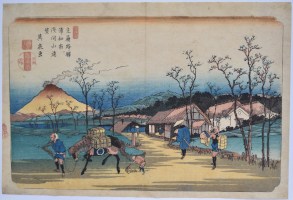
Click here to view image full size.
Urawa Shuku Asamayama enbo, “Urawa Station, Distant View of Mount Asama” from Kisokaido rokujukyutsugi no uchi, “Sixty-Nine Stations of the Kisokaido.” The set was published by Hoeido and Kinjudo, 1834-1842. The first 23 (of 70) prints were designed by Eisen, the rest by Hiroshige. In the distance can be seen a smoking Mount Asama. Although there is regular volcanic activity, the last bad eruption was in 1783.
Very good impression of the first edition with signature. (This was removed on later states.) Very good colour. Slight centre fold, otherwise very good condition. Signed Eisen ga.
Status: Sold
BUNSEI (Active c. 1830 -1844)
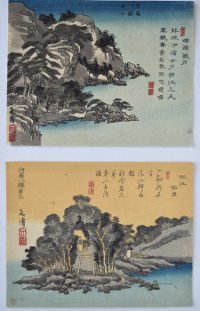
Click here to view image full size.
A complete set of Eight Views of Xiaoxiang, modern Hunan Province, China. These eight views were taken up by Japanese artists such as Hiroshige and transposed to Japan becoming sets like the Eight Views of Omi, etc. Bunsei was a pupil of Tani Buncho. He seems to have made a speciality of this subject and there is a slightly larger version set of the same subject. Published c. 1830s. Provenance: Ex Hayashi with his seal on most of the designs. Rare complete.
Very good impressions and colour. Minor edge wormage, othwerwise very good condition. Each signed Bunsei.
Status: Sold
Utagawa KUNIYOSHI (1797-1861)
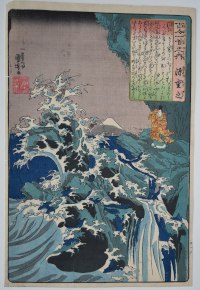
Click here to view image full size.
A poem by the celebrated poet Minamoto no Shigeyuki from the series Hyakunin isshu no uchi, “One Hundred Poems for One Hundred Poets” which was compiled in 1235 by Fujiwara Teika (1162-1241). Shows the poet on a craggy outcrop with waves crashing around him; Fuji in the distance. One of the best designs in the set published by Ebisuya Shoshichi, Ebine, 1840-42. Only 58 of the 100 are known. Various translations of the poem exist, here is one:
Waves that beat against the rocks
Fanned by a fierce wind –
It is I alone
Who breaks, those times
When I think of her
Very fine impression. Fine colour and condition. Signed Ichiyusai Kuniyoshi ga. Hiroshige ga.
Status: Sold
Kikukawa EIZAN (1787-1867)
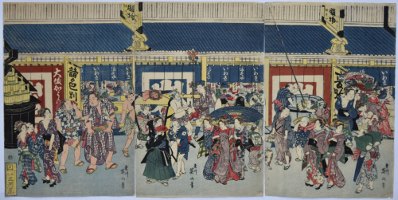
Click here to view image full size.
A triptych showing a street thronged with people in front of the famous department store Iwaki Masuya, giving a good cross-section of the inhabitants of the city at this time. The store specialised in silk and textiles and was one of the most important in Edo having, at one point, 500 employees in its stores. Hiroshige designed another triptych of this subject in c. 1850.
Published by Mikawaya Seiemon, c. 1815. Rare.
Fine impression. Extremely fine fresh colour. Fine condition. Full size. Signed Kikukawa Eizan fude.
Status: Sold
Shotei HOKUJU (1763-1825)
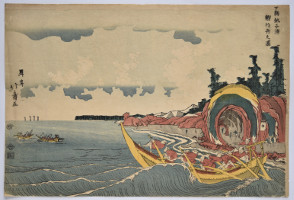
Click here to view image full size.
Shimosa Choshi no ura katsuo tsuribune, “Fishing for Bonito in Choshi Bay in Shimosa Province.” Hokuju, a pupil of Hokusai, produced a number of these fine “westernized” landscapes designed with stylised clouds, cubistic mountains and shadows cast by figures. This is one of the best. Bonito is a favourite fish in Japan where it is in the markets from around May each year. Choshin Bay has always produced the largest seafood catch in Japan. Hokuju produced a substantial body of work in this vein. However, he was not the only one. Okyo, Toyoharu, Hokusai, Kunitora, Kuninao and Shinsai also designed prints in this genre, as well as other artists producing examples. Interestingly, Hiroshige, the pre-eminent landscape artist, designed nothing like this. Indeed, the influences flowed the other way before too long, Hiroshige being a favourite of the Impressionists. This is the rare first edition published by Eijudo, c. 1820. His landscapes were republished by Yamamoto. Rare.
Fine impression and colour. Very good condition. Full size. Signed Shotei Hokuju ga.
Status: Sold
Hasegawa SADANOBU I (1809-1879)
Click here to view image full size.
A chuban landscape from a set of at least 30 prints: Miyako meisho no uchi, “Famous Places in the Capital [Kyoto].” This design, Shijo-bashi yori Nawate-dori Yamato-bashi o nozumo, “View from Shijo Bridge Towards Yamato Bridge at Nawate Street.” A fine set, inspired by Hiroshige, but not slavish copies and some excellent designs (as the snow scene here). Published by Wataya Kihei-ban, 1858.
Fine, early impression. Fine colour and, apart from the usual imperceptible fold, fine condition. Signed Sadanobu ga.
Status: Sold
Hasegawa SADANOBU I (1809-1879)
Click here to view image full size.
A chuban landscape from a set of at least 30 prints: Miyako meisho no uchi, “Famous Places in the Capital [Kyoto].” This design, Ryoan-ji yuki [no] akebono, “Snowy Dawn at Ryoan-ji Temple.” A fine set, inspired by Hiroshige, but not slavish copies and some excellent designs (as the snow scene here). Published by Wataya Kihei-ban, 1858.
Fine, early impression. Fine colour and, apart from the usual imperceptible fold, fine condition. Signed Sadanobu ga.
Status: Sold
Hasegawa SADANOBU I (1809-1879)
Click here to view image full size.
A chuban landscape from a set of at least 30 prints: Miyako meisho no uchi, “Famous Places in the Capital [Kyoto].” This design, Toganoo monzen uchu, “Temple Entrance at Toganoo in the Rain.” A fine set, inspired by Hiroshige, but not slavish copies and some excellent designs (as the rain scene here). Published by Wataya Kihei-ban, 1858.
Fine, early impression. Fine colour and, apart from the usual imperceptible fold, fine condition. Signed Sadanobu ga.
Status: Sold
Tsukioka YOSHITOSHI (1839-1892)
Click here to view image full size.
The ronin Yazama Shinroku Fujiwara Mitsukaze ) from Seichu gishinden, “Tales of True Loyalty.” From a rare uncompleted set of the 47 Ronin published 6/1868 by Masudaya. Thirteen designs extant. It has been suggested that the set was completed but that the others are not known based on the fact that two of the prints are numbered 3 and 46. An error as artists did not commence and progress from number 1. Artists chose at random which numbers from a set to start with. Well known examples being Hiroshige’s Tokaido and Kisokaido.
Very good impression and colour. Small backed wormage and light album backing. Signed Ikkaisai Yoshitoshi hitsu.
Status: Sold
Tsukioka YOSHITOSHI (1839-1892)
Click here to view image full size.
The ronin Okudera Kouemon Fujiwara Hidetomi ( number 7 ) from Seichu gishinden, “Tales of True Loyalty.” From a rare uncompleted set of the 47 Ronin published 6/1868 by Masudaya. Thirteen designs extant. It has been suggested that the set was completed but that the others are not known based on the fact that two of the prints are numbered 3 and 46. An error as artists did not commence and progress from number 1. Artists chose at random which numbers from a set to start with. Well known examples being Hiroshige’s Tokaido and Kisokaido.
Very good impression and colour. Light album backing. Signed Ikkaisai Yoshitoshi hitsu.
Status: Sold
Tsukioka YOSHITOSHI (1839-1892)
Click here to view image full size.
The ronin Muramatsu Sandayu Fujiwara Takano ( number 46 ) from Seichu gishinden, “Tales of True Loyalty.” From a rare uncompleted set of the 47 Ronin published 6/1868 by Masudaya. Thirteen designs extant. It has been suggested that the set was completed but that the others are not known based on the fact that two of the prints are numbered 3 and 46. An error as artists did not commence and progress from number 1. Artists chose at random which numbers from a set to start with. Well known examples being Hiroshige’s Tokaido and Kisokaido.
Very good impression and colour. Small backed wormhole and light album backing. Signed Ikkaisai Yoshitoshi hitsu.
Status: Sold
Keisai EISEN (1790-1848)
Click here to view image full size.
The bridge over the Ina River at Nojiri, Nojiri Inagawabashi enkei, from Kisokaido rokujukyutsugi no uchi , “Sixty-Nine Stations of the Kisokaido.” The set of seventy prints was published by Hoeido in 1835, but in 1837 Hiroshige took over and completed the series with the publisher Iseya Rihei (Kinjudo). The conjecture is that Hiroshige was the better known and more commercial artist, reinforced by the fact that Eisen’s name was removed from the designs already published. Hence only the first editions have his signature on those prints. Shows the cascade beneath the bridge, the underside of which resembles Mount Fuji. Top left, just visible in the mist, are the steps leading to the Kiyomizu Temple of Kiso. (Now a world heritage site, famous for the wooden stage jutting out over the mountainside supported by 139 12-meter high keyaki wood pillars.) One of the best designs from the set. Provenance: Ex Grabhorn collection.
Fine impression. Extremely rare in this early printing: There are a number of different states with alternative colouring to the hills, variant gradation below the falls, losing the blue mountains in the distance and without the flight of geese behind the bridge. Only the first edition has the geese, the blue mountains and the Eisen signature (as here). Fine colour. Margins trimmed a little, otherwise very good condition. Signed Keisai ga.
Status: Sold
Keisai EISEN (1764-1824)
Click here to view image full size.
Itahana from Kisokaido rokujukyutsugi no uchi, “Sixty-Nine Stations of the Kisokaido.” The set of seventy prints was started by Eisen and published by Hoeido in 1835, but in 1837 Hiroshige took over and completed the series with the publisher Iseya Rihei (Kinjudo). One of the best designs from the set. This design is never signed, even, as here, on the first edition. Rare.
Fine impression and colour. This is the first edition with gradation on the river and the river bank. Fine condition.
Status: Sold
Tsukioka YOSHITOSHI (1839-1892)
Click here to view image full size.
The ronin Okuda Sadaemon Fujiwara Yukitaka ( number 42 ) from Seichu gishinden, “Tales of True Loyalty.” From a rare uncompleted set of the 47 Ronin published 6/1868 by Masudaya. Thirteen designs extant. It has been suggested that the set was completed but that the others are not known based on the fact that two of the prints are numbered 3 and 46. An error as artists did not commence and progress from number 1. Artists chose at random which numbers from a set to start with. Well known examples being Hiroshige’s Tokaido and Kisokaido.
Very good impression and colour. Light album backing. Signed Ikkaisai Yoshitoshi hitsu.
Status: Sold
Keisai EISEN (1790-1848)
Click here to view image full size.
Itahana from Kisokaido rokujukyutsugi no uchi, “Sixty-Nine Stations of the Kisokaido.” The set of seventy prints was started by Eisen and published by Hoeido in 1835, but in 1837 Hiroshige took over and completed the series with the publisher Iseya Rihei (Kinjudo). One of the best designs from the set. This design is never signed, even, as here, on the first edition. Rare.
Fine impression and colour. This is the first edition with gradation on the river and the river bank. Slight centre fold, otherwise fine condition. Ex Pulverer collection and purchased from me in 1974.
Status: Sold
Cho Jun and Ri Ki wrestling underwater
In the new offerings is a vertical Yoshitoshi diptych of Cho Jun and Ri Ki wrestling underwater. This is the earliest known state of what is considered one of Yoshitoshi’s best designs – before the first publisher’s name (Matsui Eikichi) and date (20,2,1887) in lower left margin was printed. This gives an opportunity to examine the differences in printing between the earliest and last editions. (The diptych was subsequently reprinted by Hasegawa Tsunejiro in 1,9,1887.)
From the late 18th century there was a history of publishing some prints in a deluxe edition and a more affordable version of the same design: Paper, pigments and nuances in printing could all be adjusted. And by the time we come to some of Hiroshige’s better known sets we find the first editions had great care lavished on them with extra bokashi (grading the pigment by hand), better pigments and paper. The Hundred Views of Edo is a prime example of this: Every care was taken to convey the atmosphere of a scene. Later editions lack these subtleties with commercial considerations taking precedent. This is certainly true of many of Yoshitoshi’s sets as well.
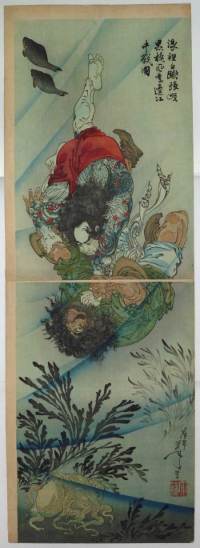
The impression offered here shows all the attributes of the earliest printing: Extremely beautiful and careful wiping of the blue block to render the currents of water; careful modulation of the gradation on the fish at top and also on the sea-weed at the bottom. The later printings – even the first with Matsui Eikichi – lack finesse in the printing of the water and in the republished version there is often no attempt to gradate the foreground sea-weed. The pigments are also of a finer quality on this early state , a better red being used on Cho Jun’s trousers. It was the job of the printers to breathe life, so to speak, into the image, to give form and depth by means of skilled bokashi; to augment a design by wiping on clouds or spraying pigment to imitate dust or snow. This all took time rather than relying on a key-block outline and blocks of colour.The only other difference, of course, between early and late printings is the quality of the impression. The more prints that were pulled, the more the blocks wore down producing weak outlines.
A Twist of Figured Cloth – Shunga wood blocks
This is the first of an occasional blog that I hope clients will find interesting.
In the current update is an important and rare set of six original wood blocks for a shunga (erotic) book Aya no odamaki “A Twist of Figured Cloth” by Terasawa Masatsugu (active c1760-1790) published in 1776 in black and white, so these are the key-blocks (or sumi-blocks) which constitute reversed or mirror-images of the book.
It is pure serendipity that a few original blocks have survived. Many were planed down to recut as wood became more expensive during the 19th century and a lot more were probably used for kindling or destroyed by fire. There is also an apocryphal story that the Victoria and Albert Museum, here in London, burnt a large number of blocks after the Second World War to free up storage space. Early blocks, such as these, are particularly rare. Blocks that survive with big names attached – Harunobu or Hiroshige, for example, are invariably for copies. Shunga blocks are of added rarity. Indeed, this is the only set I have seen . The blocks have a great beauty in their own right and are from the wood of the single-petaled white mountain cherry (shiro-yamasakura or Prunus mutabilis).
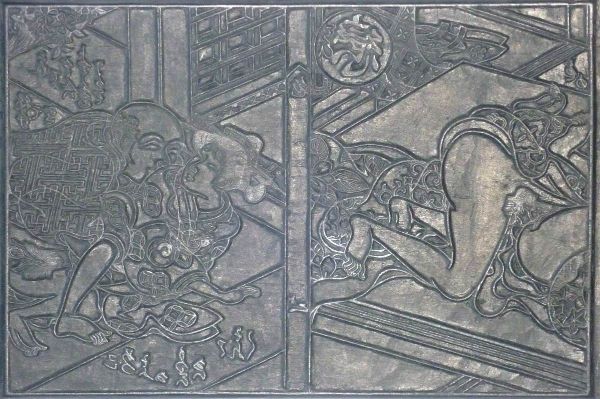
During the Edo period outlines were cut following the direction of the brush strokes of the original drawing, the knife being drawn towards the block-cutter. The block- cutter followed the drawing (hanshita-e) which was pasted face downward onto the block and partially peeled or rubbed with hempseed oil to render it more visible. Cutting was deeper in the 18th century and became shallower during the 19th, probably due to the cost of wood and the gradual sophistication of the cutters. In Japan wood was cut with the grain; this method is fundamentally similar to western chiaroscuro woodcuts, hence the operation is one of relief printing as opposed to intaglio. The impression from the grain of the wood-block was transferred to the paper during printing and is visible on early impressions – an infallible way of recognising genuine impressions rather than copies.
Colour prints used proofs from the key-block to make the colour blocks and were keyed by the simple expedient of marks (notches) cut in the block on the upper and lower left corners. Cutting of a set of blocks could take two or three days while complicated sets were finished within twenty days.
The blocks are priced separately to give as many collectors as possible the opportunity to acquire one, and would sit well with any serious collection of prints, books or shunga.
Utagawa KUNISADA II (1823-1880)
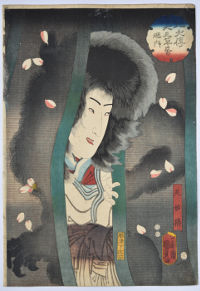
Click here to view image full size.
The actor Segawa Kikunojo V in the role of Ama Myochin, the Cat Witch, from the set Hakkenden inu no soshi no uchi, the Eight Dog Heroes, published by Tsutaya Kichizo, 5/1852. The play was premiered at the Ichimura-za Theatre, 1/1852. This is the highlight of the play: The monstrous cat murders the father of the dog hero Inamura Kakutaro and then assumes his likeness. However, as shown here, its hairy body and giant claws can still be seen behind the bamboo curtain. The best design from the set.
Very fine impression with blind printing and burnishing. Fine colour and condition. This is the only full size impression I have seen as they almost always come from albums and are trimmed to the common denominator. Another (trimmed) impression is illustrated full page in Japanese Prints IV- Hiroshige and the Utagawa school – Rijksprentenkabinet/Rijksmuseum, Amsterdam, 1984, no. 180, page 105. Signed Ichiyosai Kunisada ga.
Status: Sold
Utagawa KUNIYOSHI (1797-1861)
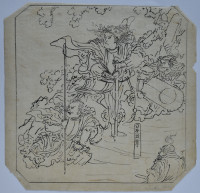
Click here to view image full size.
A fine original sumi drawing (hanshita-e) for an unpublished print for the set Tokaido gojusan tsui, “Fifty-three Parallels for the Tokaido Road.” The set was published by various publishers in 1845-6 and was a collaboration with Kunisada and Hiroshige. Sumi on thin paper. This is a design for the lower half of the oban print, the top half having the title and a panel with the name of the post-station. Shows Yamato Takeru no Mikoto. A legendary prince, son of the Emperor Keiko. Shown here with his retainers.
In extremely good condition. Provenance: Purchased from me in 21/11/1975. Rare.
Status: Available
